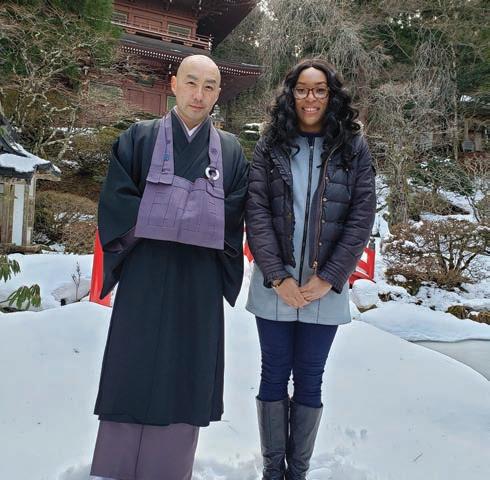
2 minute read
JAPANESE PROGRAM PROVIDES SENIOR WITH CROSSCULTURAL INSIGHT

Deyjah Foster '19 ChE with the Temple Master for the Hakkasan Hokoji Temple in Aomori, Japan
For several Villanova Engineering seniors, it was a year of tremendous accomplishments that went beyond even the joy of graduating. In addition to Fulbrights, National Science Foundation Graduate Research Fellows and Knight-Hennessy Scholars, the class of 2019 included a participant in Japan’s Kakehashi Project.
Deyjah Foster ’19 ChE was one of less than 200 American students competitively selected for this unique program sponsored by the Japanese Ministry of Foreign Affairs and coordinated by the Japan International Cooperation Center and the Japanese American Citizens League. For nine days, she and 22 other Pennsylvania college students joined fellow participants from across the country in visiting Japan’s historical and educational sites, experiencing traditional and cultural activities, and participating in lectures and workshops. The goal of the program is to foster US-Japan relations, facilitate crosscultural understanding, and encourage international leadership and business opportunities.
During a visit centered on Aomori (the northernmost region on the main island) that included home-stays, temple and museum visits, university exchanges, and local cuisine, Foster was struck by the connections between Japan’s aging demographics and topics learned in a sustainable engineering course she took at Villanova. “The country’s aging population is dramatically affecting communities in the more rural areas such as Aomori. There is tension between the increasing pressures of urbanization and Japan’s initiatives for cultural revitalization.” In addition to a forecasted 24% drop in population by 2050, increasing numbers of young adults are leaving their rural homes for college and not returning, resulting in fewer jobs, food security concerns and vanishing communities.
“Nevertheless,” notes Foster, “those concerns are met with innovative and active steps by both the government
and individual parties.” For instance, schools are emphasizing the importance of agriculture and rebranding farming as both an intrinsically and financially fulfilling career, and local farmers have opened their farms to fruit picking and tourism activities as sources of income. Additionally, Japan has begun offering residents business and marketing programs, daycare, housing and insurance incentives to improve growth in agriculture and population. “I have witnessed how engineering—focused on creating current and future opportunities for economic, environmental and societal growth—can be a driver towards improved food security and tourism,” she says.
Impacted by the once-in-a-lifetime experience, Foster concludes: “Although short, my time in the Kakehashi Project led to long-lasting relationships and cultural ties. The project highlighted not only the importance of the United States’ political alliance with Japan, but also the value of sustainable development partnerships and international relationships. Food security and drastic population changes are global concerns; however, uniting people and countries despite geographical, cultural and language differences is one of the first steps towards international solutions.”
Foster—who taught herself Japanese beginning at a young age and is now fluent in the language—was selected as Pennsylvania’s representative to present the Kakehashi Project to foreign service diplomats. After graduation, she returned home to the island of Saint Thomas and became a summer resident and teaching assistant for Math Behind the Science, a program in which recent high school graduates develop the calculus, reading and college preparation skills needed before their first year on-campus. In August, Foster began working as an engineer in research and development for Mars Wrigley in Hackettstown, New Jersey.









